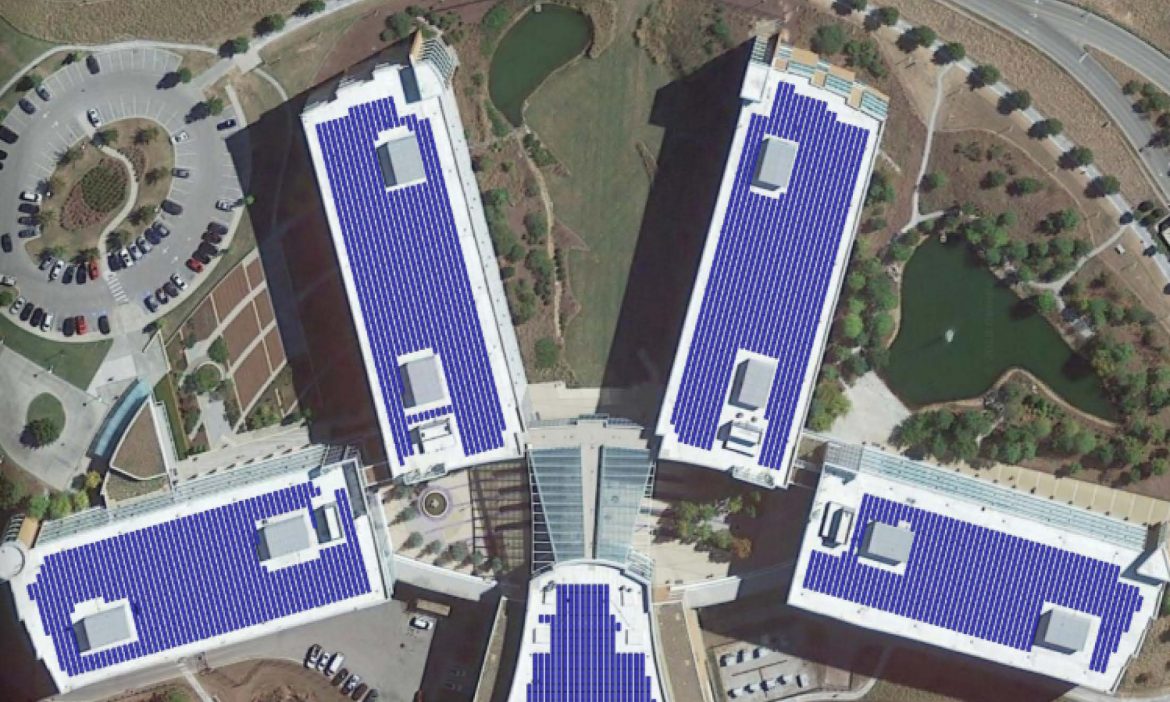Key Takeaways
- BlueCross will install 10,000 solar panels to generate power and help manage operating costs for our customers.
- Energy costs savings are expected to reach $23 million during the projected use of the solar equipment.
- Like earning LEED certification for our headquarters, this investment demonstrates our commitment to sustainability.
BlueCross will be prepared to make the most of the sunny days ahead with the addition of a major solar installation at our Cameron Hill and Gateway facilities in downtown Chattanooga.
Benefiting from all-day exposure
The first part of the installation begins in April and will expand solar arrays atop each Cameron Hill building and in the Gateway building parking lots. Additional installations will take place in July on the highest levels of the employee parking garage. All of these locations offer abundant space and receive direct sun exposure throughout the day.
As a mission-driven not-for-profit, we take a long-term view on financial responsibility. Investing in solar energy will provide advantages in the years to come for the customers and communities we serve.
“We expect to save $23 million in energy costs over the projected useful life of the solar equipment,” says John Giblin, executive vice president and chief financial officer.
“This long-term return on investment will help us lower operating costs and deliver better value for our members over time.”
Capacity for a crowd
When it’s completed, the new array will have 4 megawatts (4,000 kilowatts) of power-generating capacity.
For comparison, the EPB Solar Share in Chattanooga generates 1.4 megawatts, and the Chattanooga Airport solar farm generates 2.1 megawatts.
The 10,000 panels in the new installation will operate at 20 times the capacity of the current system. Generating about 5 million kilowatt (kW) hours of power annually, the system will offset an average of 25 percent of our overall energy needs for the Cameron Hill and Gateway facilities. On especially bright days, it will be able to generate 100 percent (or more) of our daily power needs for these locations.

The environmental impact includes several bright spots:
- The annual carbon reduction represented by the array is equal to the amount of carbon stored in 5,000 acres of trees.
- The expanded installation will save the energy equivalent of 400,000 gallons of gasoline per year.
“Solar technology provides renewable energy that reduces our reliance on more traditional energy resources,” says Jeff Sundean, vice president of properties and corporate services.
BlueCross began its solar-power journey in the Scenic City in 2011, installing panels atop the roof of the Gateway building at the foot of Cameron Hill that generate 198 kW of energy.
In addition to the Chattanooga array, we have an 82-kW installation at the Memphis office, which offsets a portion of that facility’s energy consumption.
How it works
Power is generated whenever the panels have access to sunlight. During full sun, energy production could exceed our actual needs.
While it’s theoretically possible to generate enough power to meet 100 percent of our demand, battery storage is still very expensive when it comes to storing large amounts of power for long periods. That’s why it’s estimated that, on average, solar power will offset about 25 percent of our real usage.
“Battery technology is expensive, but it’s always improving,” Jeff adds. “My hope is that our investment in solar technology will affirm the company’s commitment to sustainability.”
Did you know?
All BlueCross BlueShield of Tennessee offices are LEED Certified, meaning they meet the U.S. Green Building Council’s standards for environmentally friendly, energy-efficient buildings.
The Chattanooga facilities at Cameron Hill and Gateway are LEED Gold, as are the offices in Nashville, Knoxville and Johnson City. Our 50-year-old Memphis office was the first commercial building in the city to earn Platinum LEED certification – the highest level possible – after its 2016 transformation.
Our sustainability efforts are one more way we can support the communities where we live and work.

 Drew joined BlueCross in 2017, specializing in employee benefit communications. He has a decade of experience in journalism and marketing. A lifelong resident of the Scenic City, Drew enjoys the area’s outdoor recreation and growing musical community.
Drew joined BlueCross in 2017, specializing in employee benefit communications. He has a decade of experience in journalism and marketing. A lifelong resident of the Scenic City, Drew enjoys the area’s outdoor recreation and growing musical community.